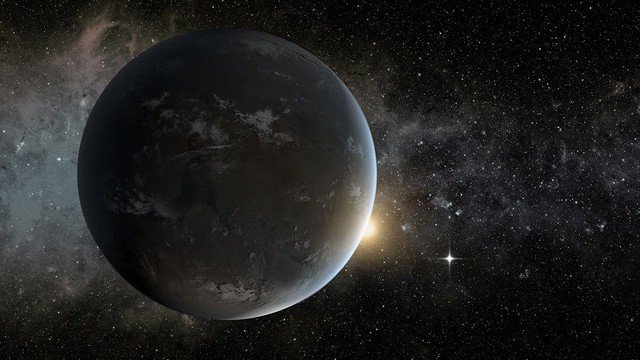New planet appears that may have life like Earth
A research team led by astronomer Xavier Dumusque from the University of Geneva (Switzerland) announced that they have identified three new planets orbiting an "unusual" star called HD 20794.
One of the three new planets, HD 20794d, could be a rocky planet similar to Earth and located right in the star's "habitable zone."

Super-Earth HD 20794d could be a habitable planet - Graphic image: NASA
According to Sci-News, HD 20794 is a bright G6V-type star located 19.7 light-years away in the constellation Eridanus.
Also known as LHS 19 or e Eri, this star hosts at least three giant exoplanets: HD 20794b, HD 20794c, and HD 20794d.
These three planets have orbital periods of 18.3, 89.7, and 647.6 days, and masses of 2.2, 3, and 5.8 times the mass of Earth, respectively.
Among them, super-Earth HD 20794d is of most interest because calculations show that it is located in the "habitable zone" of its parent star, the area that ensures the existence of liquid water, like Earth, Venus and Mars in the Solar System.
There's one slight difference: Instead of following a relatively circular orbit like Earth or Mars, HD 20794d follows an elliptical orbit, meaning the distance between the planet and its star changes greatly as it rotates.
The planet thus oscillates between the inner edge of the "habitable zone" and the outer edge of it in its orbit.
This leads to extreme changes between seasons, but according to scientists it was beneficial in helping life arise.
'If there is water on HD 20794d, the water will change from ice to liquid state, favorable for life to appear' - Dr. Dumusque affirmed.
More specifically, the "unusual" thing about this planet's parent star that scientists mentioned is its surprisingly good brightness and closeness.
Coupled with the large size of the surrounding planets, observing them is extremely convenient compared to other known exoplanets.
"The HD 20794 system is a high-priority target for future atmospheric characterization by direct imaging means," the authors wrote in a paper published in the scientific journal Astronomy & Astrophysics.
You should read it
- The discovery of the 'Second Earth' can exist only 4.2 light-years away from Earth
- Discovering another 'super Earth' can appear to live only 21 light-years away
- Learn the secret of Mars formation
- Learn about extraterrestrial super-Earth - Gliese 581c
- Top 5 planets may be our 'new houses' in the future
- History of Earth formation and 25 milestones (Part I)
- Interesting facts about Mars may be unknown to you
- Admire the unique photograph of the Moon and Earth taken from Mars
May be interested
- Breakthrough solar panels that can withstand even the biggest storms
 the french center for materials formation has developed a solar panel system that can withstand even heavy storms.
the french center for materials formation has developed a solar panel system that can withstand even heavy storms. - Space collision sends NASA lost on another planet
 the data nasa's insight spacecraft has collected from our neighbor may have produced some major errors.
the data nasa's insight spacecraft has collected from our neighbor may have produced some major errors. - More than 1,000 new asteroids discovered thanks to 'photobomb' phenomenon
 the hubble space telescope is famous for its clear, eye-catching images of distant galaxies, and is also useful in helping to study objects within our own solar system.
the hubble space telescope is famous for its clear, eye-catching images of distant galaxies, and is also useful in helping to study objects within our own solar system. - Warning signs you may be lactose intolerant
 lactose intolerance occurs in people who lack the enzyme needed to break down lactose, the sugar in milk. here are common signs of lactose intolerance.
lactose intolerance occurs in people who lack the enzyme needed to break down lactose, the sugar in milk. here are common signs of lactose intolerance. - Interesting facts about dinosaurs you may not know
 dinosaurs have become some of the strangest animals to ever exist on this planet. here are some of the most amazing facts about dinosaurs you can imagine.
dinosaurs have become some of the strangest animals to ever exist on this planet. here are some of the most amazing facts about dinosaurs you can imagine. - Interesting facts about bread you may not know
 bread is not only one of many people's favorite foods, it has also been a part of human culture and symbolism since long before recorded history.
bread is not only one of many people's favorite foods, it has also been a part of human culture and symbolism since long before recorded history.






 The discovery of the 'Second Earth' can exist only 4.2 light-years away from Earth
The discovery of the 'Second Earth' can exist only 4.2 light-years away from Earth History of Earth formation and 25 milestones (Part I)
History of Earth formation and 25 milestones (Part I) Top 5 planets may be our 'new houses' in the future
Top 5 planets may be our 'new houses' in the future A terrifying object that made life on Earth evolve by leaps and bounds?
A terrifying object that made life on Earth evolve by leaps and bounds? Discovered 20 Earth-like planets that could contain life
Discovered 20 Earth-like planets that could contain life